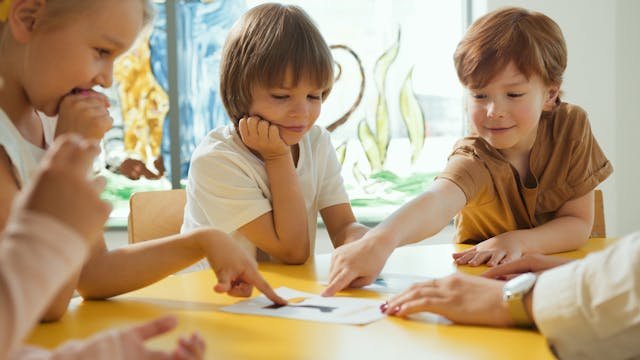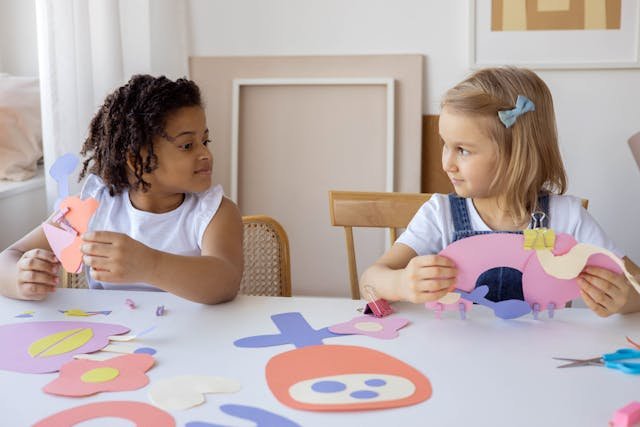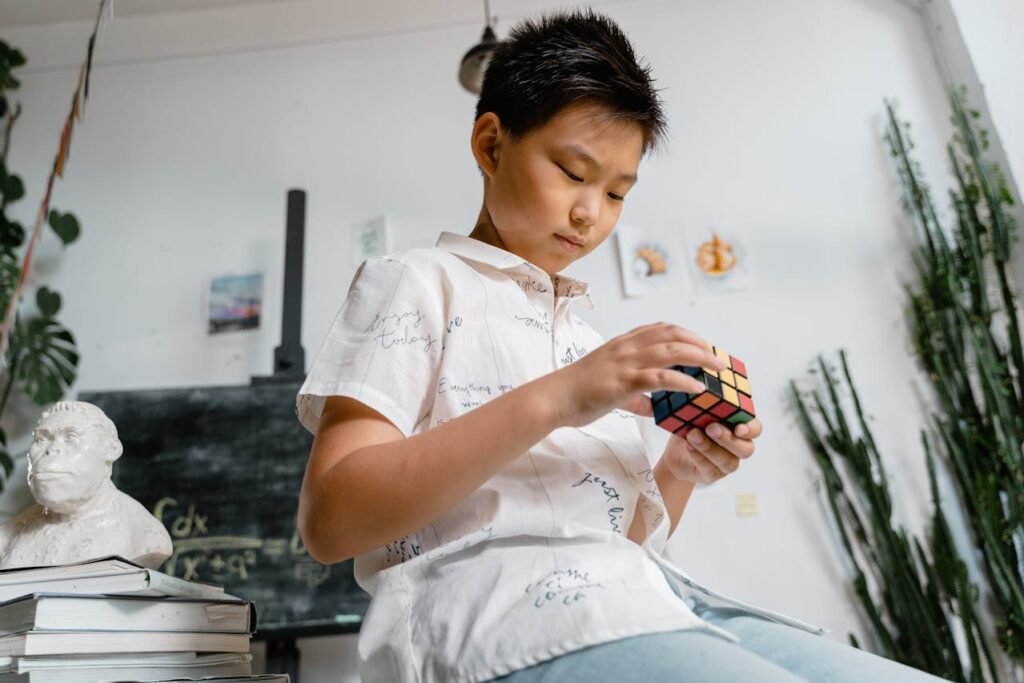Children don’t all think in the same way. A five-year-old looking at the world is not using the same kind of thinking as a teenager. In fact, the way children think changes as they grow—and two of the most important ways are called concrete thinking and abstract thinking.
Concrete thinking is about what you can see, touch, and experience directly. Abstract thinking is about ideas, possibilities, and things you cannot always see. Both are important, and both develop over time.
In this article, we’re going to explore the difference between concrete and abstract thinking in childhood, how each one shows up at different ages, and why both are essential for learning. We’ll also look at how parents and teachers can support children as they move from one way of thinking to the other.
Concrete Thinking in Early Childhood (Ages 3–7)
Concrete thinking is the first stage of how children understand the world. At this age, children rely on their senses and direct experiences. If they can see it, touch it, hear it, or do it, they can usually understand it. But if it’s invisible, imagined, or symbolic, it may feel confusing.
For example, a four-year-old understands that a ball is round, that it bounces when dropped, and that it rolls across the floor. But if you tell them the ball “represents freedom” in a poem, they won’t get it. That’s because abstract meanings don’t make sense yet—they need things to be real and concrete.
Everyday Signs of Concrete Thinking
You can see concrete thinking in almost everything young children do. When you ask a five-year-old what “time flies” means, they may look up at the sky for flying clocks. To them, words are taken literally. A joke or metaphor may confuse them.
Concrete thinking also shows up in how they solve problems. If a puzzle piece doesn’t fit, they keep trying until it does. If water spills, they wipe it up. They don’t think about “why” something happened in a bigger sense—they just deal with what’s in front of them.
Learning Through Play
Play is the most powerful way concrete thinkers learn. Stacking blocks teaches balance. Pretend cooking with toy food teaches process. Drawing a house teaches them about shapes and space. At this stage, learning is physical, hands-on, and immediate.
This is also why subjects like math and reading are introduced with concrete examples first. Kids count blocks, sort objects, or trace letters. These concrete activities prepare their brains for more abstract versions—like solving equations or writing essays—later on.
Emotions and Concrete Thinking
Concrete thinkers also see emotions in direct ways. If a friend shares a toy, they’re “good.” If someone grabs a toy, they’re “bad.” They don’t yet understand deeper motives or perspectives. For them, everything is black-and-white, tied to visible actions.
Parents and teachers can help by talking about feelings in simple terms: “She grabbed the toy because she was excited, not because she doesn’t like you.” Slowly, this helps children move beyond surface-level thinking and into more flexible ways of understanding others.
Concrete thinking is not a weakness—it’s a foundation. It gives children the building blocks of logic, language, and problem-solving. But as they grow, they begin to reach for more. Their minds start to stretch beyond what they can see. That’s when abstract thinking begins to appear.
Abstract Thinking Begins (Ages 8–12)

Around the ages of 8 to 12, children start making an important shift. While they still rely heavily on concrete thinking, small sparks of abstract thinking begin to appear. Their world slowly expands from “what I can see” to “what I can imagine.”
For example, a nine-year-old may understand that “time flies” doesn’t mean clocks with wings—it means time passes quickly. They begin to recognize that words and ideas can carry symbolic meanings, not just literal ones. This is the first sign of abstract thought.
Schoolwork as a Gateway
School plays a big role in this shift. Math moves from counting blocks to working with multiplication and division—concepts you can’t always see but can imagine in your mind. Reading moves from simple sentences to stories with deeper meanings. Children start to pick up themes, morals, and lessons in books, even if they are not directly stated.
In science, they begin to think about things they can’t see directly, like the air around them or the way planets move in space. Even though these ideas are invisible, they learn to imagine them, reason about them, and connect them to the world they know.
Social Understanding Expands
Abstract thinking also changes the way children understand people. At age 6, they may see someone as simply “mean” if they don’t share. By age 10, they can start to understand motives: “Maybe she didn’t share because she was having a bad day.”
This shows that children are beginning to think beyond what is directly visible. They are considering invisible factors—feelings, reasons, perspectives—that affect how people behave.
The “What If” Stage
Another clear sign of abstract thinking is the rise of “what if” questions. Children at this age start asking: “What if the Earth didn’t have gravity?” or “What if animals could talk?” These are not questions about what they see—they are about possibilities.
This ability to imagine different scenarios is powerful. It’s the root of creativity, invention, and problem-solving. It also prepares them for more advanced reasoning as teenagers.
Challenges of the Transition
Even though abstract thinking is growing, children between 8 and 12 often switch back and forth between concrete and abstract thought. Sometimes they grasp symbolic meanings; other times, they still take things literally. Parents and teachers may notice moments of maturity mixed with moments of simplicity. This is completely normal.
The best way to support them is to encourage both sides—give them concrete examples to anchor their learning, but also invite them to imagine, question, and explore beyond what they see.
This stage is like standing at a bridge. On one side is the solid ground of concrete thinking; on the other is the open sky of abstract thought. Between ages 8 and 12, children begin crossing that bridge, step by step.
Abstract Thinking in the Teenage Years (Ages 13–18)

By the time children reach their teenage years, abstract thinking begins to take center stage. This doesn’t mean concrete thinking disappears—it’s still important and useful—but teens can now handle ideas that go far beyond what they can see or touch.
They can think about concepts like justice, freedom, love, and morality—things that can’t be measured or held. They can imagine the future, plan long-term goals, and even reflect on who they are and who they want to become. This is a major leap from the simpler, here-and-now thinking of early childhood.
Big Questions and Deeper Ideas
Teenagers are known for asking big, sometimes challenging questions: “What is the meaning of life?” “Why do people have to die?” “Why are there unfair rules in society?” These questions show their growing ability to think abstractly.
They are no longer satisfied with simple answers like “because that’s how it is.” They want reasons, causes, and possibilities. This questioning, though sometimes frustrating for parents, is actually a sign of healthy intellectual growth.
Abstract Thinking in School
In academics, abstract thinking is essential at this age. Teenagers can understand algebra, geometry, and science theories that involve invisible forces and complex systems. They can analyze literature not just for the story but for the deeper meaning behind it.
For example, a 14-year-old reading a novel may notice themes like courage, loyalty, or betrayal, even if those words are never mentioned. A 16-year-old studying history may connect past events to modern issues, understanding that human choices often repeat patterns.
This ability to make connections, see patterns, and think beyond the surface is one of the strongest signs of abstract thought.
Social and Emotional Growth
Abstract thinking also transforms how teens see themselves and others. Instead of simply noticing what someone does, they consider why people act a certain way, what values guide them, and how their own identity fits into the bigger picture.
This is why adolescence is often a time of self-discovery. Teens reflect on questions like: Who am I? What do I believe? What do I want to do with my life? These are not concrete problems with simple answers. They are abstract explorations that help shape their future.
The Balance Between Concrete and Abstract
Even though teens are capable of abstract thought, they still rely on concrete thinking at times—especially when facing new or stressful situations. For example, when learning to drive, a teen must focus on very concrete skills like turning the wheel or checking mirrors. Over time, once those concrete skills are mastered, abstract thinking takes over, allowing them to anticipate traffic, predict other drivers’ behavior, and plan safe decisions.
This shows that both types of thinking work together. Concrete thinking provides the solid steps, while abstract thinking offers the bigger vision.
In short, the teenage years are when abstract thinking blossoms. It gives young people the tools to dream, to plan, to question, and to create. It is what transforms them from children who see only what is in front of them into young adults who can imagine what could be.
Concrete vs Abstract Thinking: Understanding the Differences

Concrete thinking and abstract thinking are not opposites—they are partners. Each has its own role in helping children understand the world. The key is knowing what makes them different and why both are necessary for healthy development.
Concrete Thinking: The Foundation
Concrete thinking is grounded in reality. It deals with things that are physical, visible, and measurable. Children using concrete thought focus on what they can see and do right now.
For example:
- If you give a five-year-old two apples, they know they are holding two apples.
- If you say, “Don’t touch, it’s hot,” they may test it once and then quickly learn the rule from the experience.
Concrete thinking is essential because it gives children a solid base. Without it, they wouldn’t understand numbers, shapes, language, or even everyday rules. It’s like the roots of a tree—deep, strong, and necessary for growth.
Abstract Thinking: The Expansion
Abstract thinking stretches beyond what is directly in front of us. It’s about ideas, possibilities, and connections. Teenagers and adults use abstract thought to plan ahead, imagine different outcomes, or understand values and symbols.
For example:
- A 12-year-old learning about freedom understands it’s not just about opening a door—it’s about rights, choices, and opportunities.
- A 16-year-old reading a poem doesn’t only see the words, but also interprets hidden meanings, feelings, and metaphors.
Abstract thinking is what allows us to dream, create, solve complex problems, and understand others on a deeper level. It’s like the branches of a tree—spreading out, reaching high, and connecting in many directions.
Why Both Matter
Some people might think abstract thinking is “better” because it’s more advanced. But the truth is, both are equally important. Without concrete thinking, abstract ideas float without grounding. Without abstract thinking, concrete knowledge stays limited to what is seen.
Take math as an example. Counting blocks is concrete. Solving algebra is abstract. But the two are connected—you can’t solve algebra unless you first understand numbers.
Or take social life. Sharing a toy is concrete. Understanding why sharing builds friendship is abstract. Together, they shape not just what a child does, but why they do it.
A Lifelong Dance
Even adults move between concrete and abstract thinking every day. A chef measures ingredients (concrete) but also imagines how flavors combine (abstract). A driver follows traffic lights (concrete) but also predicts what another driver might do (abstract).
For children, the journey from concrete to abstract is not about replacing one with the other. It’s about learning to use both—starting with what they can touch, then slowly reaching toward what they can imagine.
Supporting Concrete and Abstract Thinking in Children

Children don’t move from concrete to abstract thinking overnight. It’s a slow, layered process that happens with the right environment, practice, and encouragement. Parents and teachers are the guides who help children build strong foundations while also stretching their minds toward bigger ideas.
Supporting Concrete Thinking
In the early years, children need hands-on learning. The more they can touch, see, and do, the more they understand. Parents and teachers can support this by:
- Offering puzzles, blocks, and building sets that require trial and error.
- Using real-life objects to explain new ideas—for example, using apples to teach counting instead of just numbers on a page.
- Letting children experiment freely, even if it means messes or mistakes. Spilled water while pouring teaches balance, measurement, and control better than words alone.
Concrete experiences are powerful because they anchor ideas in reality. A child who has counted real apples will better understand the idea of “five” when it appears in math problems later.
Supporting Abstract Thinking
As children grow, they need gentle pushes into abstract territory. Parents and teachers can spark abstract thinking by asking open-ended questions like:
- “What do you think will happen if…?”
- “Why do you think she felt that way?”
- “Can you imagine another way to solve this?”
Stories, art, and role-play are also great tools. When children read a book, don’t just ask, “What happened?” Ask, “What lesson do you think the character learned?” or “How would you feel if you were in that situation?” These questions move children beyond the surface and into deeper reflection.
Math and science, too, are perfect for abstract growth. Once a child understands multiplication with blocks, show them how it connects to patterns or future predictions. Once they’ve seen how water freezes, ask them to imagine what would happen without freezing in nature. These extensions stretch their thinking further.
Balancing Both
It’s important not to rush children into abstract thinking before they’re ready. A six-year-old may not understand justice, but they can grasp fairness if you show it through sharing toys. Step by step, fairness turns into justice as they grow.
The best approach is to balance both: give children solid, concrete experiences, then gently layer abstract ideas on top. Think of it like climbing stairs—each step builds on the one before it, leading higher and higher.
Encouragement and Patience
The biggest gift adults can give is encouragement. A child who feels safe to ask questions, make mistakes, and share ideas will naturally stretch their thinking. Patience is also key—abstract thinking comes at different times for different children, and that’s okay. The goal is progress, not perfection.
How Debsie Helps Children Develop Both Concrete and Abstract Thinking

At Debsie, we understand that children don’t just need knowledge—they need the right kind of thinking at the right stage of life. That’s why our teaching approach supports both concrete thinking in younger children and abstract thinking as they grow older. By meeting children where they are, we help them build confidence step by step until they’re ready for deeper ideas and complex challenges.
Concrete Thinking in the Early Years
For children ages 3 to 7, Debsie focuses on playful, hands-on learning. Our teachers use real-life objects, stories, and interactive activities to anchor lessons in concrete experiences. A math lesson might begin with counting blocks or fruit. A science lesson might involve melting ice cubes or planting seeds.
By connecting learning to the real world, children not only understand better but also stay engaged. They see, touch, and feel the lesson—and that makes it unforgettable.
Stretching into Abstract Thinking
As children enter the middle years (ages 8 to 12), our lessons gently stretch them toward abstract ideas. Instead of just counting, they start spotting patterns. Instead of only hearing stories, they begin to explore themes and hidden meanings.
For example, in a history class, younger kids might learn what happened in a battle, while older children discuss why it happened and what it means for today. In science, they might move from watching a plant grow to imagining ecosystems and energy cycles.
This transition is carefully guided. We never push children too quickly, but we always challenge them just enough to spark growth.
Abstract Thinking in the Teenage Years
For teens (ages 13 to 18), Debsie lessons go deeper into abstract and critical thinking. Our teachers guide students to analyze, connect, and reflect. Math lessons might include algebra and problem-solving strategies that require imagining possibilities. Literature lessons go beyond plots to explore symbolism, emotions, and philosophy.
We also bring abstract thinking into real-world contexts. Teens work on projects, debates, and problem-based learning that connect what they study to life outside school. They don’t just memorize answers—they learn to question, explore, and create.
Building Life Skills Alongside Learning
At every stage, Debsie helps children see that thinking is not just for school—it’s for life. Concrete thinking builds practical skills, while abstract thinking nurtures creativity, empathy, and problem-solving. Together, they prepare children to face real challenges with clarity and confidence.
This is the heart of our approach: combining expert teaching with age-appropriate strategies that turn every child into a confident thinker, ready for both today’s lessons and tomorrow’s challenges.
👉 Book a free trial class today and watch how Debsie can help your child grow from concrete learning to abstract brilliance.
Final Thoughts: The Journey from Concrete to Abstract
Children don’t just wake up one day thinking abstractly. They grow into it. They start with the concrete—counting blocks, touching objects, and learning through play. Slowly, they begin to imagine, question, and reflect, stretching their minds toward the abstract. By the time they reach their teenage years, they’re able to explore big ideas, weigh possibilities, and dream about the future.
Both kinds of thinking matter. Concrete thinking gives children solid ground. Abstract thinking gives them wings. Together, they shape a child into a confident learner and a thoughtful human being.
At Debsie, we guide children along this journey step by step. Our expert teachers understand when a child needs hands-on learning and when they’re ready for deeper, abstract challenges. We make learning clear, joyful, and empowering at every stage of growth.
👉 Book a free trial class today
👉 Explore Debsie’s courses for ages 5–18
Because the most powerful thing we can give children is not just knowledge—it’s the ability to think, in every sense of the word.
Read Next:



